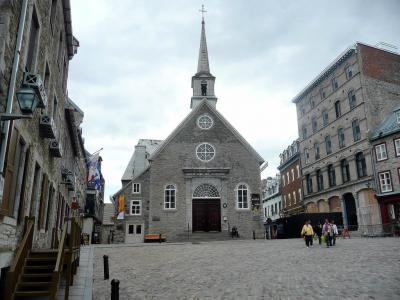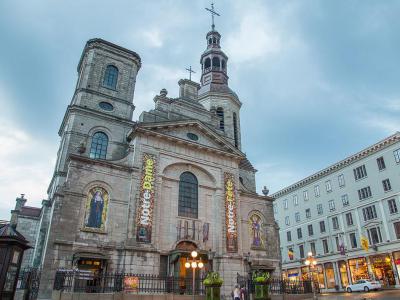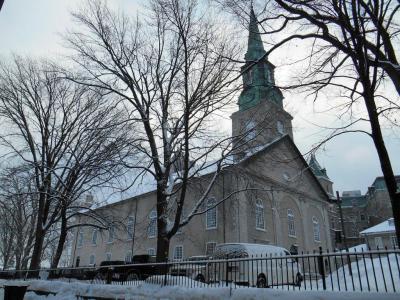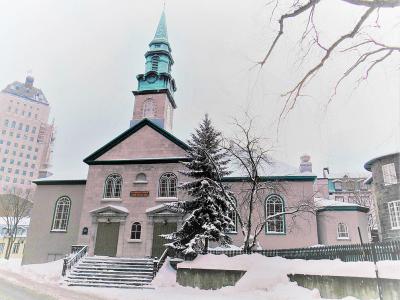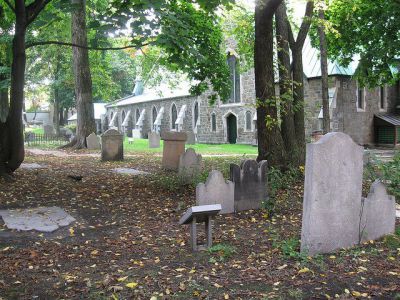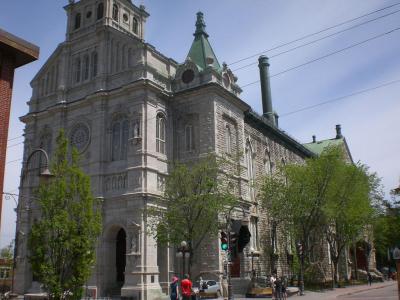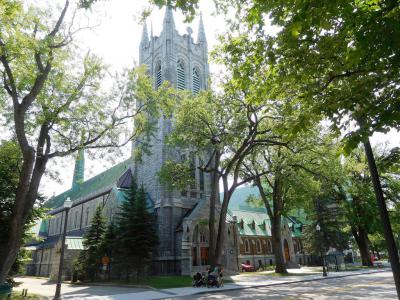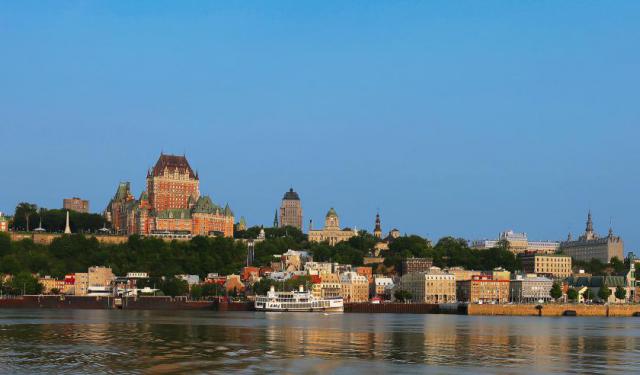
Qucbec City's Historical Churches Walking Tour (Self Guided), Quebec City
The first religious buildings in Canada were established by the Récollets and Jesuits, in 1615 and 1625, respectively, when they first arrived in New France. Later on, the French colonists brought along their culture and architectural traditions, and the establishment of British and evangelical society triggered further major developments in Quebec City.
Over the course of the 17th and 18th centuries, Quebec City firmly established itself as a center of Catholicism in North America, with the most prominent and well-known religious site from that period being the Basilica-Cathedral of Notre-Dame de Québec – one of the oldest cathedrals on the continent and the mother church of the Catholic Archdiocese of Quebec.
Another prominent Roman Catholic church, of Saint John the Baptist (Église Saint-Jean-Baptiste), renowned for its intricate stonework and ornate decorations, is found in the eponymous neighborhood of the city and was built in the late 1800s. Saint John the Baptist, the patron saint of Quebec, is fervently venerated each year here at the dedicated festival. It takes place on June 24th, a public holiday in Quebec, and is celebrated with parades, fireworks, and other festivities.
While predominantly Catholic, Quebec City is also home to several other significant places of worship of Protestant, Pentecostal, and other Christian denominations. The Anglican Church of Canada has a presence in the city, as does the United Church of Canada. The Cathedral of the Holy Trinity, in the heart of Old Quebec, featuring Palladian style, is the seat of the Anglican Diocese of Quebec and was built in the early 19th century.
Quebec City's spiritual scene reflects a diverse range of beliefs and practices, including a strong tradition of pilgrimage, all of which is manifested in numerous churches, chapels, and other institutions, sometimes several centuries-old, dotting the downtown area.
For a more detailed acquaintance with the peculiarities of Quebec City's spirituality and architecture, embark on this self-guided quest.
Over the course of the 17th and 18th centuries, Quebec City firmly established itself as a center of Catholicism in North America, with the most prominent and well-known religious site from that period being the Basilica-Cathedral of Notre-Dame de Québec – one of the oldest cathedrals on the continent and the mother church of the Catholic Archdiocese of Quebec.
Another prominent Roman Catholic church, of Saint John the Baptist (Église Saint-Jean-Baptiste), renowned for its intricate stonework and ornate decorations, is found in the eponymous neighborhood of the city and was built in the late 1800s. Saint John the Baptist, the patron saint of Quebec, is fervently venerated each year here at the dedicated festival. It takes place on June 24th, a public holiday in Quebec, and is celebrated with parades, fireworks, and other festivities.
While predominantly Catholic, Quebec City is also home to several other significant places of worship of Protestant, Pentecostal, and other Christian denominations. The Anglican Church of Canada has a presence in the city, as does the United Church of Canada. The Cathedral of the Holy Trinity, in the heart of Old Quebec, featuring Palladian style, is the seat of the Anglican Diocese of Quebec and was built in the early 19th century.
Quebec City's spiritual scene reflects a diverse range of beliefs and practices, including a strong tradition of pilgrimage, all of which is manifested in numerous churches, chapels, and other institutions, sometimes several centuries-old, dotting the downtown area.
For a more detailed acquaintance with the peculiarities of Quebec City's spirituality and architecture, embark on this self-guided quest.
How it works: Download the app "GPSmyCity: Walks in 1K+ Cities" from Apple App Store or Google Play Store to your mobile phone or tablet. The app turns your mobile device into a personal tour guide and its built-in GPS navigation functions guide you from one tour stop to next. The app works offline, so no data plan is needed when traveling abroad.
Qucbec City's Historical Churches Walking Tour Map
Guide Name: Qucbec City's Historical Churches Walking Tour
Guide Location: Canada » Quebec City (See other walking tours in Quebec City)
Guide Type: Self-guided Walking Tour (Sightseeing)
# of Attractions: 7
Tour Duration: 2 Hour(s)
Travel Distance: 2.9 Km or 1.8 Miles
Author: susan
Sight(s) Featured in This Guide:
Guide Location: Canada » Quebec City (See other walking tours in Quebec City)
Guide Type: Self-guided Walking Tour (Sightseeing)
# of Attractions: 7
Tour Duration: 2 Hour(s)
Travel Distance: 2.9 Km or 1.8 Miles
Author: susan
Sight(s) Featured in This Guide:
- Notre-Dame-des-Victoires (Our Lady of Victories Church)
- Notre-Dame de Québec
- Cathedral of the Holy Trinity
- St. Andrew's Presbyterian Church
- St. Matthew's Cemetery
- Eglise Saint-Jean-Baptiste (Saint John the Baptist Church)
- Eglise Saint-Dominique (Saint Dominique Church)
1) Notre-Dame-des-Victoires (Our Lady of Victories Church)
While exploring Quebec City's Lower Town (Basse-Ville), you'll discover the charming Catholic basilica, Our Lady of Victories (Notre-Dame-des-Victoires), on Royal Square (Place Royale). This basilica boasts Neoclassical design and a distinctive spire-topped steeple. It holds the distinction of being the oldest stone church in Canada and one of the oldest in North America. The church, constructed between 1687 and 1723, stands on the site of Samuel de Champlain's former residence, the city's founder.
Originally dedicated to the baby Jesus (l'Enfant Jésus), the church was renamed Our Lady of Victory after the Battle of Quebec in 1690. In 1711, it changed its name to "of Victories" following the sinking of British Admiral Hovenden Walker's fleet due to bad weather. Despite suffering damage during the British bombardment before the Battle of the Plains of Abraham in September 1759, the church was fully restored in 1816.
Today, it holds the status of a historic monument and continues to attract tourists while serving as a place of worship. Recent restoration efforts have returned the church to its original French colonial style. Despite various renovations spanning centuries, some original elements from the 1600s, such as a basement wall fragment and the turret on the facade, still remain.
The austere church interior features 17th to 19th-century paintings by artists like Van Dyck, Rubens, and Boyermans, as well as unique frescoes depicting local history by artist Jean-Marie Tardivel. Most captivating is a suspended replica of the 17th-century vessel Le Brézé, used to transport French soldiers to New France in 1664 under Marquis de Tracy. It was salvaged from church ruins in 1759.
In 2002, the church gained recognition as a filming location for the movie "Catch Me If You Can," featuring Leonardo DiCaprio and Tom Hanks.
Originally dedicated to the baby Jesus (l'Enfant Jésus), the church was renamed Our Lady of Victory after the Battle of Quebec in 1690. In 1711, it changed its name to "of Victories" following the sinking of British Admiral Hovenden Walker's fleet due to bad weather. Despite suffering damage during the British bombardment before the Battle of the Plains of Abraham in September 1759, the church was fully restored in 1816.
Today, it holds the status of a historic monument and continues to attract tourists while serving as a place of worship. Recent restoration efforts have returned the church to its original French colonial style. Despite various renovations spanning centuries, some original elements from the 1600s, such as a basement wall fragment and the turret on the facade, still remain.
The austere church interior features 17th to 19th-century paintings by artists like Van Dyck, Rubens, and Boyermans, as well as unique frescoes depicting local history by artist Jean-Marie Tardivel. Most captivating is a suspended replica of the 17th-century vessel Le Brézé, used to transport French soldiers to New France in 1664 under Marquis de Tracy. It was salvaged from church ruins in 1759.
In 2002, the church gained recognition as a filming location for the movie "Catch Me If You Can," featuring Leonardo DiCaprio and Tom Hanks.
2) Notre-Dame de Québec (must see)
The Cathedral-Basilica of Our Lady of Quebec City (Notre-Dame de Québec) is the oldest church in Canada. It sits on the site of the former chapel of Our Lady of Recovery (Notre Dame de la Recouvrance), which was built by Samuel de Champlain in 1633.
This is also the first church in Canada to be ranked as a minor basilica – by Pope Pius IX, in 1874.
Over the years, the cathedral has been destroyed twice by fires: the first time during the Siege of Quebec, in 1759; and then in 1922, gutted by arson by the members of the Canadian faction of the Ku Klux Klan.
The church was designated a National Historic Site of Canada in 1989. Inside, you will find a chancel lamp donated by Louis XIV and impressive adornments such as stained glass windows, paintings of the Virgin Mary dating back to the French colonial regime, the old bishop's throne, and a stunning gold-plated baldaquin canopy suspended above the altar.
From 1654 to 1898, some 900 people were buried in the church crypt; among them four governors of New France and twenty bishops of Quebec, including François de Laval, Quebec's first bishop. It is also rumored that Samuel de Champlain himself is buried somewhere nearby; archaeologists have been searching for his grave for decades.
In 2014, when the cathedral celebrated its 350th anniversary, a holy door – a special entrance portal traditionally located within the Papal major basilicas in Rome – was installed here, being the only one of its kind in North America and one of eight across the entire world.
Tip:
See the basilica during the day, but consider the laser light show in the evening. The line to get in is very long, so buy your tickets online and pick them up at the office the night of the performance. Not the cheapest 30 minutes, but well worth it if you want to see the magnificent building shine in a whole new way.
Entry is free for self-guided visits; it is also possible to visit the crypt on a guided tour, for a charge.
This is also the first church in Canada to be ranked as a minor basilica – by Pope Pius IX, in 1874.
Over the years, the cathedral has been destroyed twice by fires: the first time during the Siege of Quebec, in 1759; and then in 1922, gutted by arson by the members of the Canadian faction of the Ku Klux Klan.
The church was designated a National Historic Site of Canada in 1989. Inside, you will find a chancel lamp donated by Louis XIV and impressive adornments such as stained glass windows, paintings of the Virgin Mary dating back to the French colonial regime, the old bishop's throne, and a stunning gold-plated baldaquin canopy suspended above the altar.
From 1654 to 1898, some 900 people were buried in the church crypt; among them four governors of New France and twenty bishops of Quebec, including François de Laval, Quebec's first bishop. It is also rumored that Samuel de Champlain himself is buried somewhere nearby; archaeologists have been searching for his grave for decades.
In 2014, when the cathedral celebrated its 350th anniversary, a holy door – a special entrance portal traditionally located within the Papal major basilicas in Rome – was installed here, being the only one of its kind in North America and one of eight across the entire world.
Tip:
See the basilica during the day, but consider the laser light show in the evening. The line to get in is very long, so buy your tickets online and pick them up at the office the night of the performance. Not the cheapest 30 minutes, but well worth it if you want to see the magnificent building shine in a whole new way.
Entry is free for self-guided visits; it is also possible to visit the crypt on a guided tour, for a charge.
3) Cathedral of the Holy Trinity
The Cathedral of the Holy Trinity is the cathedral of the Anglican Diocese of Quebec and is located in Quebec City. The cathedral was founded in 1793 with the establishment of the Diocese of Quebec, and its first bishop, Dr. Jacob Mountain, soon began efforts to build a cathedral. The building was designed by military officers William Robe and William Hall and was constructed between 1800 and 1804.
The Cathedral of the Holy Trinity was consecrated on August 28, 1804, becoming the first Anglican cathedral to be built outside of the British Isles. The cathedral was designed in the neoclassical Palladian style and was modeled after Saint Martin-in-the-Fields Church in Trafalgar Square, London, and the Marylebone Chapel (now known as Saint Peter, Vere Street). King George III paid for the construction of the cathedral and provided a folio Bible, communion silverware, and large prayer books to be used for worship.
In addition to its architectural significance, the Cathedral of the Holy Trinity has played an important role in the history of Quebec and Canada. The cathedral was used as a hospital during the cholera epidemic of 1832 and was also the site of the first performance of Handel's Messiah in Canada in 1852.
Today, the Cathedral of the Holy Trinity is a National Historic Site of Canada and continues to serve as an important place of worship for the Anglican community in Quebec City. The cathedral's bell-tower is home to eight bells founded by the Whitechapel Bell Foundry in 1830, which are the oldest change-ringing peal in Canada.
The Cathedral of the Holy Trinity was consecrated on August 28, 1804, becoming the first Anglican cathedral to be built outside of the British Isles. The cathedral was designed in the neoclassical Palladian style and was modeled after Saint Martin-in-the-Fields Church in Trafalgar Square, London, and the Marylebone Chapel (now known as Saint Peter, Vere Street). King George III paid for the construction of the cathedral and provided a folio Bible, communion silverware, and large prayer books to be used for worship.
In addition to its architectural significance, the Cathedral of the Holy Trinity has played an important role in the history of Quebec and Canada. The cathedral was used as a hospital during the cholera epidemic of 1832 and was also the site of the first performance of Handel's Messiah in Canada in 1852.
Today, the Cathedral of the Holy Trinity is a National Historic Site of Canada and continues to serve as an important place of worship for the Anglican community in Quebec City. The cathedral's bell-tower is home to eight bells founded by the Whitechapel Bell Foundry in 1830, which are the oldest change-ringing peal in Canada.
4) St. Andrew's Presbyterian Church
Saint Andrew's Presbyterian Church in Quebec City has a long history dating back to 1759 when it was founded by Church of Scotland Chaplain Robert MacPherson and members of the 78th Fraser Highlanders during the British conquest of Quebec. As Scottish and New England merchants settled in the area, the congregation grew and became known as the Scotch Congregation.
In 1802, during the ministry of Alexander Spark, King George III granted the church its current location, and construction work began in 1807. The church was officially dedicated on November 30, 1810, which is Saint Andrew's Day, and it was named in honor of the apostle. The church's architecture has remained largely unchanged over the years, except for the addition of the Vestry in 1900. The church complex also includes the Kirk Hall and the Manse, which served as the ministers' residence until 2017.
Notably, the renowned Canadian musician William Reed held the position of organist at the church from 1900 to 1913. With its rich historical significance and cultural heritage, Saint Andrew's Presbyterian Church continues to be a prominent religious institution in Quebec City.
In 1802, during the ministry of Alexander Spark, King George III granted the church its current location, and construction work began in 1807. The church was officially dedicated on November 30, 1810, which is Saint Andrew's Day, and it was named in honor of the apostle. The church's architecture has remained largely unchanged over the years, except for the addition of the Vestry in 1900. The church complex also includes the Kirk Hall and the Manse, which served as the ministers' residence until 2017.
Notably, the renowned Canadian musician William Reed held the position of organist at the church from 1900 to 1913. With its rich historical significance and cultural heritage, Saint Andrew's Presbyterian Church continues to be a prominent religious institution in Quebec City.
5) St. Matthew's Cemetery
Saint Matthew's Cemetery has a long and fascinating history dating back to the 18th century. It was founded in 1772, shortly after the British conquest of Quebec City, as a burial ground for the city's English-speaking Protestant community. At that time, Quebec City was predominantly Catholic, and the English-speaking community was small but growing.
The cemetery is located on a hill overlooking the Saint Lawrence River and the Lower Town of Quebec City, and it was originally known as the "Protestant Burying Ground." The first burials in the cemetery were simple affairs, with graves marked by wooden crosses or rough stones. Over time, as the English-speaking community in Quebec City grew, the cemetery expanded, and more elaborate tombstones and monuments were erected.
Saint Matthew's Cemetery became the final resting place for many prominent figures in Quebec City's history, including politicians, military leaders, artists, and entrepreneurs. Notable individuals buried in the cemetery include Lieutenant Colonel John By, who oversaw the construction of the Rideau Canal, and Robert Sellar, a journalist and historian who chronicled the early history of Quebec.
Over the years, the cemetery has undergone several renovations and restorations to preserve its rich heritage. In 1977, it was designated a National Historic Site of Canada, recognizing its importance to the country's cultural and historical landscape. Today, Saint Matthew's Cemetery remains an important landmark in Quebec City and a peaceful oasis in the heart of the city.
The cemetery is located on a hill overlooking the Saint Lawrence River and the Lower Town of Quebec City, and it was originally known as the "Protestant Burying Ground." The first burials in the cemetery were simple affairs, with graves marked by wooden crosses or rough stones. Over time, as the English-speaking community in Quebec City grew, the cemetery expanded, and more elaborate tombstones and monuments were erected.
Saint Matthew's Cemetery became the final resting place for many prominent figures in Quebec City's history, including politicians, military leaders, artists, and entrepreneurs. Notable individuals buried in the cemetery include Lieutenant Colonel John By, who oversaw the construction of the Rideau Canal, and Robert Sellar, a journalist and historian who chronicled the early history of Quebec.
Over the years, the cemetery has undergone several renovations and restorations to preserve its rich heritage. In 1977, it was designated a National Historic Site of Canada, recognizing its importance to the country's cultural and historical landscape. Today, Saint Matthew's Cemetery remains an important landmark in Quebec City and a peaceful oasis in the heart of the city.
6) Eglise Saint-Jean-Baptiste (Saint John the Baptist Church)
The Saint John the Baptist Church has a rich history dating back to the late 19th century. The church was built between 1882 and 1887 in the Gothic Revival style by architect Joseph-Ferdinand Peachy. The project was funded by donations from the local French-Canadian community, who wanted to create a church that would reflect their cultural and religious heritage.
The church's interior features stunning stained-glass windows, intricate wood carvings, and beautiful paintings that depict scenes from the Bible and the history of Quebec. The church's façade is equally impressive, with its two towering spires, intricate stonework, and ornate decorations.
Over the years, Saint John the Baptist Church has played an essential role in the religious and cultural life of Quebec City. The church has served as a gathering place for the local community, hosting weddings, baptisms, and other important events.
In addition to its cultural and religious significance, Saint John the Baptist Church has also been an important symbol of the French-Canadian community's struggle for recognition and rights. During the 1960s and 1970s, the church was a hub of activism and social change, with many local residents gathering there to protest against discrimination and injustice.
Today, Saint John the Baptist Church is a vibrant and active parish, continuing to serve the needs of the local community and visitors from around the world.
The church's interior features stunning stained-glass windows, intricate wood carvings, and beautiful paintings that depict scenes from the Bible and the history of Quebec. The church's façade is equally impressive, with its two towering spires, intricate stonework, and ornate decorations.
Over the years, Saint John the Baptist Church has played an essential role in the religious and cultural life of Quebec City. The church has served as a gathering place for the local community, hosting weddings, baptisms, and other important events.
In addition to its cultural and religious significance, Saint John the Baptist Church has also been an important symbol of the French-Canadian community's struggle for recognition and rights. During the 1960s and 1970s, the church was a hub of activism and social change, with many local residents gathering there to protest against discrimination and injustice.
Today, Saint John the Baptist Church is a vibrant and active parish, continuing to serve the needs of the local community and visitors from around the world.
7) Eglise Saint-Dominique (Saint Dominique Church)
The idea to build a parish church on Grande Allée Ouest, in the La Cité-Limoilou borough of Quebec City, emerged in 1925. The design of the English-style neo-Gothic building was by architect Joseph-Albert LaRue. The construction lasted from 1929 to 1930, resulting in a Latin-cross-plan temple with a rectangular nave, aisles, transept, and choir.
The building is clad in white granite and topped with a gable roof covered in copper, with a campanile at the crossroads. An imposing tower porch, rising in the center of the façade, is flanked by two side annexes.
The first mass at Saint Dominique's was celebrated on Christmas 1930.
The Dominican Convent by the church was established in 1934. On January 1, 1939, a fire destroyed part of the convent, following which, in 1940, the property underwent thorough restoration, complete with sculptural and other ornamentation by artist Lauréat Vallière. After fourteen years of hard work, Vallière finished the interior in 1953, producing more than 500 sculpted figures and other stone and white oak embellishments.
The sanctuary served the Dominican order until 2010. In 2011, the convent was demolished to make way for the Pierre-Lassonde pavilion of the National Museum of Fine Arts of Quebec (Musée National des Beaux-arts du Québec). As of 2016, the church has been assigned to the parish of Saint John the Baptist (Saint Jean-Baptiste).
A designated heritage building, it forms part of the protected area of the Cornelius-Krieghoff house and, as such, remains an important cultural landmark in Quebec City.
The building is clad in white granite and topped with a gable roof covered in copper, with a campanile at the crossroads. An imposing tower porch, rising in the center of the façade, is flanked by two side annexes.
The first mass at Saint Dominique's was celebrated on Christmas 1930.
The Dominican Convent by the church was established in 1934. On January 1, 1939, a fire destroyed part of the convent, following which, in 1940, the property underwent thorough restoration, complete with sculptural and other ornamentation by artist Lauréat Vallière. After fourteen years of hard work, Vallière finished the interior in 1953, producing more than 500 sculpted figures and other stone and white oak embellishments.
The sanctuary served the Dominican order until 2010. In 2011, the convent was demolished to make way for the Pierre-Lassonde pavilion of the National Museum of Fine Arts of Quebec (Musée National des Beaux-arts du Québec). As of 2016, the church has been assigned to the parish of Saint John the Baptist (Saint Jean-Baptiste).
A designated heritage building, it forms part of the protected area of the Cornelius-Krieghoff house and, as such, remains an important cultural landmark in Quebec City.
Walking Tours in Quebec City, Quebec
Create Your Own Walk in Quebec City
Creating your own self-guided walk in Quebec City is easy and fun. Choose the city attractions that you want to see and a walk route map will be created just for you. You can even set your hotel as the start point of the walk.
Old Quebec Walk
The historic part of Quebec City known as Old Quebec (French: Vieux-Québec), sometimes also referred to as the Latin Quarter (Quartier Latin), is the neighborhood centered around Cape Diamond (Cap Diamant), located on the eastern edge of Quebec hill promontory. The area comprises Upper Town (Haute-Ville) and Lower Town (Basse-Ville) and is currently listed among UNESCO’s World Heritage Sites.
... view more
Tour Duration: 2 Hour(s)
Travel Distance: 2.6 Km or 1.6 Miles
... view more
Tour Duration: 2 Hour(s)
Travel Distance: 2.6 Km or 1.6 Miles
Quebec City Introduction Walking Tour
Cresting a cliff above the St. Lawrence River, Québec City (French: Ville de Québec) is the soul of the province of Québec – a place all its own; a country within a country with its own traditions, architecture, and French-speaking population.
The Algonquian people had originally named the area Kébec, which means "where the river narrows", because the Saint Lawrence River... view more
Tour Duration: 2 Hour(s)
Travel Distance: 3.2 Km or 2 Miles
The Algonquian people had originally named the area Kébec, which means "where the river narrows", because the Saint Lawrence River... view more
Tour Duration: 2 Hour(s)
Travel Distance: 3.2 Km or 2 Miles
Historical Houses Walking Tour
Quebec City, particularly evocative of Europe in its atmosphere, is often referred to as the cradle of New France. The city boasts one of the richest architectural heritages in North America, though most of its buildings had to be adapted to harsh winters and the lack of specialized workers and materials in the colony. As such, the majority of local houses were designed as simple and efficient... view more
Tour Duration: 2 Hour(s)
Travel Distance: 2.5 Km or 1.6 Miles
Tour Duration: 2 Hour(s)
Travel Distance: 2.5 Km or 1.6 Miles
The Most Popular Cities
/ view all
